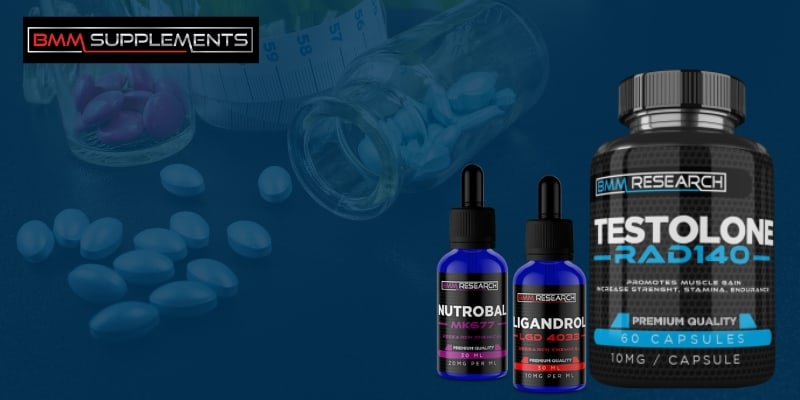- info@bmm-supplements.com
- +31-(0) 85 7430610
- Olympia 2d, 1213 NT Hilversum The Netherlands

Selective androgen receptor modulators, or SARMs, are a class of compounds that have gained popularity in recent years as potential research chemicals. Unlike anabolic steroids, SARMs have been designed to selectively bind to androgen receptors in the body, which allows them to mimic the effects of testosterone without some of the negative side effects. In this article, we will focus on three of the most commonly researched SARMs: RAD140, LGD4033, and MK677. We will discuss their benefits, potential applications, risks, side effects, legal aspects, and comparisons with other research chemicals or supplements. Additionally, we will include specific studies or research findings related to these SARMs, as well as the future of SARMs.
RAD140, also known as Testolone, is a nonsteroidal SARM that has shown potential as a treatment for muscle wasting diseases, such as cancer cachexia and sarcopenia. In addition, RAD140 has been shown to have a positive effect on bone health, which makes it a potential treatment for osteoporosis. Some of the other potential benefits of RAD140 include:
LGD4033, also known as Ligandrol, is another nonsteroidal SARM that has been shown to have a positive effect on muscle mass and strength. LGD4033 has been studied as a potential treatment for muscle wasting diseases, but it also has potential applications in sports performance and bodybuilding. Some of the potential benefits of LGD4033 include:
MK677, also known as Ibutamoren, is a nonpeptide SARM that has been shown to increase the secretion of growth hormone and insulin-like growth factor 1 (IGF-1) in the body. This makes it a potential treatment for growth hormone deficiency, but it also has potential applications in sports performance and bodybuilding. Some of the potential benefits of MK677 include:
While SARMs have shown potential benefits, they are not without risks and side effects. Some of the potential risks and side effects of SARMs include:
It’s important to note that the long-term effects of SARMs are not well-known, and more research is needed to fully understand the risks and side effects.
SARMs are currently not approved by the U.S. Food and Drug Administration (FDA) for human use, and they are not available for prescription use. However, they are legal to purchase as research chemicals for scientific study. It’s important to note that using SARMs for human consumption is illegal and can result in serious health consequences.
SARMs are often compared to anabolic steroids and prohormones, but there are some key differences between these compounds. Anabolic steroids are synthetic versions of testosterone that can have a variety of negative side effects, such as liver damage, heart disease, and infertility. Prohormones are precursors to hormones in the body and can also have negative side effects. SARMs, on the other hand, have been designed to selectively target androgen receptors in the body, which can lead to fewer negative side effects than steroids or prohormones.
In terms of comparisons with other supplements, SARMs are often compared to natural testosterone boosters, such as D-aspartic acid and tribulus terrestris. While these supplements can increase testosterone levels, they do not have the same selective targeting effect as SARMs. Additionally, natural testosterone boosters may have limited effects on muscle mass and strength compared to SARMs.
There have been numerous studies on RAD140, LGD4033, and MK677, which have shown promising results. For example, a study published in the Journal of Medicinal Chemistry found that RAD140 increased muscle mass and bone density in rats without affecting prostate size. Another study published in the Journal of Clinical Endocrinology and Metabolism found that LGD4033 increased lean body mass in healthy men without affecting prostate size or causing significant side effects. A study published in the Journal of Clinical Endocrinology and Metabolism also found that MK677 increased growth hormone and IGF-1 levels in healthy men without causing significant side effects.
As more research is conducted on SARMs, it’s possible that they could become an important tool for treating muscle wasting diseases, such as cancer cachexia and sarcopenia. Additionally, SARMs may have potential applications in sports performance and bodybuilding. However, more research is needed to fully understand the risks and benefits of these compounds.
SARMs are a class of compounds that have gained popularity as potential research chemicals due to their selective targeting of androgen receptors in the body. RAD140, LGD4033, and MK677 are three of the most commonly researched SARMs, and they have shown potential benefits for increasing lean muscle mass, strength, and bone density. However, SARMs are not without risks and side effects, and more research is needed to fully understand their long-term effects. Additionally, using SARMs for human consumption is illegal and can result in serious health consequences.
Overall, SARMs offer a potential alternative to anabolic steroids and prohormones, which can have serious negative side effects. While SARMs are not currently approved for human use, they are legal to purchase as research chemicals for scientific study. Researchers should approach SARMs with caution, as the long-term effects of these compounds are not well-known. However, as more research is conducted, SARMs may become an important tool for treating muscle wasting diseases and improving sports performance.
It’s important to note that this article is not intended to provide medical advice, and individuals should always consult with a healthcare provider before using any research chemicals or supplements. Additionally, the legal status of SARMs may vary by country or region, and individuals should always ensure that they are following the laws in their area.
